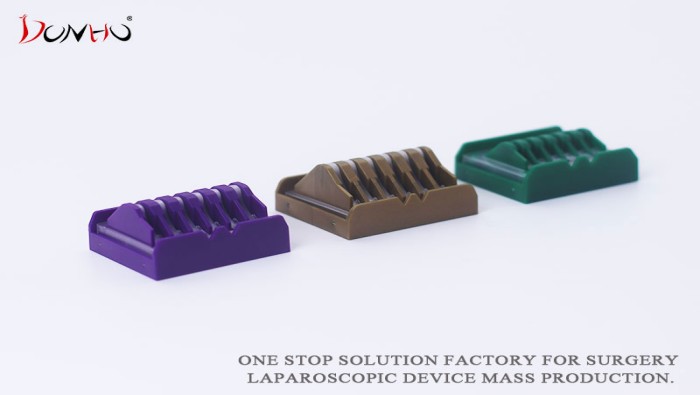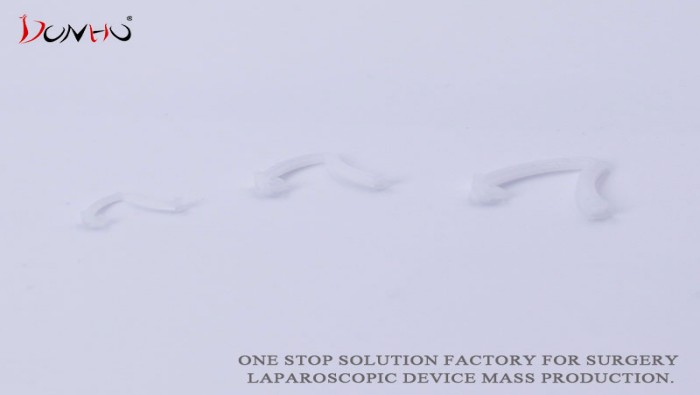

Sterilization of disposable non-degradable tissue closure clips (with paraformaldehyde POM as the core material) is directly related to device safety and clinical effectiveness. Due to the high sensitivity of POM material to sterilization methods, it is necessary to systematically control the sterilization process parameters, residues and material stability. The following four dimensions of sterilization method selection, process verification, residue control and material protection analyze the key elements of the sterilization process.

I. Sterilization method suitability assessment
Ethylene oxide (EtO) sterilization
Applicability: POM materials have good chemical resistance, EtO sterilization (temperature 40-60 ℃) will not lead to yellowing or embrittlement of the material, is the mainstream of sterilization.
Limitations: Need to control the number of sterilization cycles (recommended ≤ 20 times), to avoid long-term exposure triggered by slight hydrolysis of the material.
II.Gamma ray sterilization
Advantage: strong penetration, suitable for sterilization of large quantities of products, no risk of chemical residues.
Risks: high dose (≥25kGy) may cause POM molecular chain breakage, need to verify the sterilization of the clamping force after the attenuation (recommended ≤5%).
Electron beam sterilization
Characteristics: fast and efficient, but weak penetration, only for thin-walled or small-sized products.
Material impact: electron beam local heat generation may lead to slight oxidation of the POM surface, need to control the dose rate (≤ 10kGy/min).
Second, the sterilization process parameters optimization
Temperature and humidity control
EtO sterilization: the temperature should be strictly controlled at 50-55 ℃, humidity 40-80% RH. high humidity (> 80%) will accelerate the hydrolysis of POM, humidity is too low (< 40%) will reduce the permeability of the sterilizing agent.
Gamma sterilization: ambient temperature is recommended to be ≤40℃ to avoid the superposition of thermal effects leading to material deformation.
Sterilization dose and time
Dose setting: verify the dose according to the bioburden, and routinely use the half-cycle method (e.g., initial contamination bacteria ≤ 100 CFU/piece, sterilizing dose 25kGy).
Time control: EtO sterilization exposure time is usually 2-6 hours, overtime may increase the risk of residue.
III, Sterilization residue control
Ethylene oxide (EO) residues
Safety threshold: according to ISO 10993-7 requirements, EO residue ≤ 4μg/cm², ECH (epichlorohydrin) ≤ 9μg/cm².
Resolution process: forced ventilation resolution (50℃/humidity 30-60%RH) for more than 48 hours, combined with multiple air exchanges to reduce residues.
Irradiation by-product management
Gamma sterilization: may produce trace formaldehyde (POM degradation products), need to be detected by headspace gas chromatography, the concentration of ≤ 10ppm.
Material performance protection strategy
Sterilization tolerance verification
Mechanical properties: ≤5% attenuation of clamping force before and after sterilization (refer to YY/T 0681 standard), verified by isolated blood vessel model.
Dimensional stability: linear expansion rate ≤ 0.1% (three-dimensional optical scanning detection), to ensure that the locking mechanism with precision.
IV.Anti-aging treatment
Stabilizer addition: introducing anti-oxidant (e.g. 1010 hindered phenol) and ultraviolet absorber (e.g. UV-531) to slow down the aging of the material triggered by sterilization.
Packaging barrier: the use of aluminum foil composite film packaging, blocking oxygen and moisture, to extend the validity period after sterilization.

V. Sterilization process verification and quality control
Verification methods
Physical verification: use biological indicators (such as Bacillus subtilis black var. spores) to confirm the sterilization effect (SAL ≤ 10-⁶).
Chemical validation: EO chemical indicator card to verify the uniformity of sterilization agent penetration.
Process Monitoring
Online monitoring: real-time recording of temperature, humidity, pressure and EO concentration in the sterilization chamber, data storage ≥ product validity + 2 years.
Batch traceability: Establish the correlation system between sterilization batch number and production batch number to realize rapid recall of abnormal batches.
VI. Compliance with regulations and standards
Domestic requirements
Comply with GB 18279 (ethylene oxide sterilization), GB/T 19973 (irradiation sterilization) and “Good Manufacturing Practice for Medical Devices”.
International Certification
FDA: Meet the validation requirements of 21 CFR 880.5570 for sterilization process.
EU MDR: Provide complete sterilization process validation documents (including IQ, OQ, PQ).
Conclusion and Recommendations
Sterilization of POM tissue closure clips needs to focus on balancing sterilization efficacy and material protection, with core control points including sterilization method suitability, residue management, and material performance validation. Enterprises should establish a sterilization process design space, combined with real-time monitoring and digital traceability systems to ensure the stability of mass production. For high value-added products, it is recommended to prioritize the use of EtO sterilization and optimize the analysis.
+86 18361958211
marketing@cndonho.com
+86 18361958211
No.2 Zhiwei Road, Qiandeng Town, Kunshan City, Jiangsu Province, China




